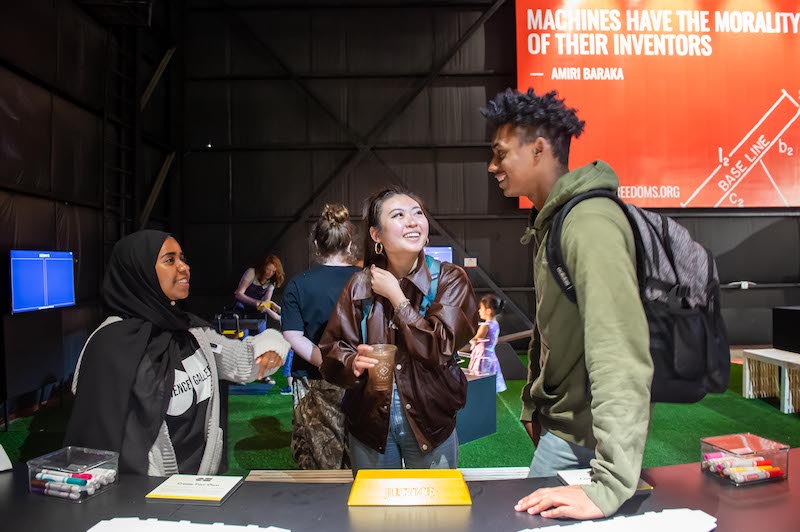Science Gallery Atlanta, with its emphasis on exploring social justice themes through intersections with art and science, is a welcome addition to Atlanta’s cultural scene. Launched in 2022 by Emory University in a building in the Pullman Yards complex, Science Gallery Atlanta is the newest member of an international network of galleries organized by research universities in Europe, Asia and the Americas.
The network’s overarching mission is to encourage collaborations between artists and researchers working in disciplines ranging from social sciences to data sciences to natural sciences. Its members are also connected by their commitment to engaging audiences, particularly young people, with issues that define our time, such as climate change. The network’s goal is not to proselytize but rather to encourage meaningful dialogues and to cultivate responsible global citizens.

Science Gallery Atlanta’s current exhibition, JUSTICE, (through September 30) is emblematic of this mission. Curated by Science Gallery Atlanta’s curator Floyd Hall, JUSTICE is a thought-provoking exhibition that examines societal systems that “govern our world and influence our lives.” Through open-call, curatorial research and the opportunity to draw upon the international Science Gallery’s projects inventory, Hall has produced an impactful exhibition around the broadly defined theme of justice.
Art and science are often built upon inquiries into issues that define our humanity, resulting in historic alliances between artists and scientists. Today, many contemporary artists have embraced evidence-based research, which is the foundation of the sciences, as critical to their practices. This has led to interesting collaborations between artists and scientists, whose dialogues have often focused on social engagement in a rapidly evolving, connected world. It is in this activist space that the Science Gallery Atlanta operates.
Questioning what makes a just society, the JUSTICE exhibition looks at issues such as the ethics of facial recognition, the labor behind coffee production and disability rights. The projects are primarily installations created by collaborative multidisciplinary teams comprised of artists, scientists, activists and thinkers. Many of the projects are Atlanta-based — some with significant Emory connections. But this is not a local exhibition but rather a dialogue among local, regional and national artists.
Based on scale alone, the most impressive installation is Destinations, a Metropolitan Atlanta Rapid Transit Authority (MARTA) bus that has been “wrapped” by Atlanta-based artist Sanithna Phansavanh. Both a designer and public artist, Phansavanh created a truly beautiful wrap referencing the natural environment. Visitors are welcomed to sit on the bus where flowers entwine the seats. Overhead transit cards ask questions about the environment, community, economic access and the role that public transit plays in connecting us to our shared futures. And a special acknowledgment to MARTA for its willingness to participate in this initiative.

In 2021, Emory launched the Arts & Social Justice Fellowship program that embeds artists with Emory researchers working in multiple disciplines. JUSTICE includes the work of several of the fellows. Notable is interdisciplinary artist Stephanie Brown’s Seesaw, a participatory artwork using the metaphor of the playground to demonstrate how social determinants, such race, education status and immigration status, impact our identities and social opportunities. Visitors select faux gold bullion bars to place on the seesaw; the bars are technologically weighted to literally contextualize perceptions about the intersectionality of conditions such as gender, race and educational achievement.
A Gainesville, Florida, collaboration led by transdisciplinary artist Katerie Gladdys, Seed Cabinet is an interactive cabinet of curiosities. Employing an old library card catalog cabinet, the artist asks visitors to open the individual drawers outfitted with various seeds and plants. This action triggers videos and audio narratives installed on top of the cabinet that explore the relationships of these plants with site-specific political and ecological ecologies. The work provides an opportunity to consider the long history of agriculture and how food systems have impacted the natural world.
For Freedoms, founded by artists Hank Willis Thomas, Eric Gottesman and Michelle Woo in 2016, is a national collaborative that uses the power of the visual arts to mount campaigns during significant moments in contemporary American politics. JUSTICE includes a salon-style installation of documentation of their projects that have been placed across the United States, as well as a large-scaled billboard by an artist known as American Art.

The artist’s design visualizes a quote by poet Amiri Baraka: Questioning the relationship between the morality of an inventor with the societal impact of the invention, Baraka speaks about the entwined relationships between enslaved people, their masters and technology. Clearly, For Freedoms doesn’t shy away from serious content.
Opportunities for community engagement are incorporated throughout the installations; gathering and reading spaces activate the exhibition as well. Mediators, many of whom are Atlanta-area college students, are on hand to discuss the projects with visitors. Several of the projects, such as data artist Carl DiSalvo’s community mapping initiative, are brought to fruition through participatory events. A stage permanently installed in the center of the exhibition facilitates discussions on justice-related topics such as racism and compassion for unhoused populations.
Science Gallery Atlanta is clear in its social justice mission. It has carved out an important, not well-explored place in Atlanta’s current cultural ecology, setting it apart from other visual arts organizations. We’ll see what the future holds.
::
Louise E. Shaw has been a cultural worker in Atlanta for over 40 years. She served as executive director of Nexus Contemporary Art Center from 1983 to 1998, and was on Eyedrum’s ad hoc advisory board in the 2000s.

